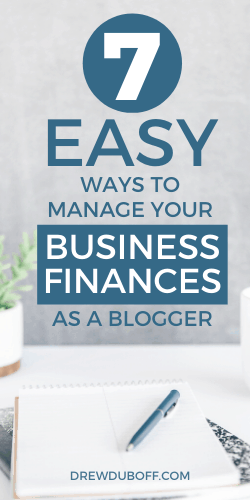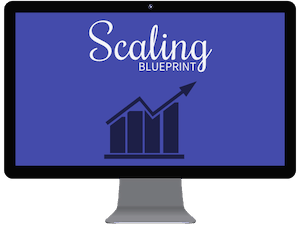
Blogging is a popular way to make money, but it’s important to know what to do with the funds you bring in so that your business will thrive.
When you run a blog, you also run a business and you need to invest your income in ways that will build your brand and increase your reach.
I use the Profit First system to manage my money and you should do the same!
Even if you don’t use the amazing system — which has allowed me to fully pay off my car and thousands in student loans — you still need to know how to manage your business finances as a blogger and what to spend money on.
I can’t tell you how many bloggers have given poor advice on this topic, so make sure you pay attention to this article.
Let’s get started!
7 Ways to Easily Manage Your Business Finances
If you’ve struggled to manage your business finances before, this article should clear up a lot of confusion.
My 7 favorite ways are:
- Using the Profit First system
- Creating a budget
- Comparing prices
- Paying for protection
- Separating business and personal finances
- Overpaying on taxes
- Buying yearly subscriptions
Let’s dive into these a little more!

1. Using the Profit First System
The Profit First system is my absolute favorite!
That’s why I listed it first 🙂
It’s modeled after the envelope method of budgeting, but it’s really more of a system for cash flow management.
I’ve used the Profit First System to pay off thousands of dollars in loans and it’s a system that makes sense for my impulsive and compulsive spending habits.
I’m a self-professed course junkie and I have sooooo many that I haven’t even opened some of them. When I started using this system, it curbed my expenses almost instantaneously because I only spent what I had in my operating expenses account.
I have five bank accounts:
- Owner’s Pay
- Operating Expenses
- Profit
- Taxes
- Personal
All the money comes into the Owner’s Pay account and I do transfers on the 10th and 25th of each month to the accounts. The book helps with providing percentages to aim for when transferring.
I use the money that comes into my personal account as spending/discretionary income.
Your profit account is what you use to fund future business ventures or projects (or to take a distribution at the end of a quarter). The rest is self-explanatory.
I do have a debit card for each account so I can charge a payment there as needed.
My friend Katie over at More With Money has an excellent guide on getting this system set up in your business.
You can purchase Profit First on Amazon to start your journey to business financial freedom.
By Mike Michalowicz
You are about to discover the profoundly simple yet shockingly effective accounting plug-in that will transform your business from a cash eating monster into a money-making machine.
2. Creating a Budget
You might already have a personal accounting system that keeps you from spending more than you bring in each month.
You need the same for your blog.
Having a budget will help you avoid spending on unnecessary items. Without a system, there is no way to tell how much money you are bringing in and where it is going.
A budget allows you to track spending so that you’ll know if the way you are using your business funds is helping or hurting your bottom line.
Budgets don’t have to be difficult to set up.
Just make sure to track earnings and spending over time and look for trends in the money.
3. Comparing Prices
Bargain shopping isn’t just necessary when creating a nice wardrobe.
It’s extremely important that you spend your business funds appropriately and responsibly, and that means you need to compare prices before committing to buying anything.
If blogging is your full-time job, there will be other products you need to invest in to keep your business growing. Don’t ever spend your money on a service or product without comparing prices from several competitors.
This will help your money last much longer.
Keep in mind, though, that differently priced products will function differently. You should determine what you actually need vs. what your money could buy you.
For example, there’s an ongoing debate about hosting. I hear Bluehost vs. Siteground quite frequently. As of writing this article, I’m hosted on Bluehost for over 2 years.
No complaints.
I was able to lock in a price for 3 years and I’ll likely stay there until then and then transfer hosts. I’ve heard stories from newer bloggers that the renewal fees on Siteground after a year are too expensive, despite how much they like them.
I’m not an affiliate for either, so I don’t have an agenda to push, but think about your investments from a long-term perspective.
My site speed has been just fine…
4. Pay for Protection
Your blog can get hacked.
If that happens, you will have to go through a very frustrating process to fix the problem, regain control of your site, and build your audience again if they have been scared away due to malicious activity.
The way to avoid that is to pay for protection upfront.
Some packages allow you to pay monthly to make sure you have eyes on your site as well as support in case something goes wrong. If you are serious about building your blog and your audience, protection is a worthwhile investment.
You can save time, stress and money with this type of service.
Remember the whole snafu when Social Warfare temporarily redirected its users to porn?
Yeah, thanks to my tech guy, we had transitioned to Social Pug in advance and I got to avoid that drama.
You can sign up for his monthly WordPress maintenance here.
It’s a bargain, for sure, and you get some premium plugins as part of your purchase.
5. Separating Business and Personal Finances
I see this question asked in Facebook groups all the time.
Should I have a separate business bank account? Should I separate my business funds?
The simple answer is that you should, but only when it makes sense to.
When you’re first starting out, your expenses and income will be minimal, so they should be easy to track from a personal account. Once you start making more money, that’s when you should open a business bank account.
You will need an EIN number to open a business bank account, so you can apply for a FREE one here.
I didn’t open a business bank account until I was making $1,000 per month. You want the bank account to be self-sufficient, so if you have to draw funds from your personal account, it’s not time yet.
I will say, though…
I had a business PayPal account from the beginning to receive affiliate payments.
You should do the same. No sense in mixing those funds.
6. Overpaying on Taxes
This might sound a little contradictory at first, but it’s one of my favorite tips.
When you overpay on taxes, you actually increase the likelihood you’ll be eligible for a return at the end of the year.
Now, I’m not a CPA nor do I claim to be one, but it’s better to have contributed too much in quarterly taxes than to have to owe and be strapped for cash.
My system for this is to calculate my state and federal estimated taxes using my spreadsheets and then overpay a few percentage points based on the funds I transferred using the Profit First system.
I’m excited for this year’s return because it should be sizeable based on our current projections. If you budget more cash for your taxes, your overall spending will be in check and surprise income can be reinvested in desirable ways.
Currently thinking of a treadmill under my desk/dining room table so I can lose weight…
Let me know what you think I should use on my return!
7. Buying Yearly Subscriptions
If you’re someone that pays for software or plugins on a monthly basis, then you’re likely missing out on discounts that are given if you pony up the funds at the beginning of your term.
This way, you’re spending money that you have currently and not funds you anticipate you’ll have (but, do budget for them if you stick to monthly).
I know some software products can be expensive, but if you save up for them in advance, you’ll be able to afford them.
I use a spreadsheet to track these renewals, too.
Some of my favorite yearly purchases are:
- Interact (email me for a reader-specific discount)
- ConvertKit
- Canva
- Social Pug
This is what I call free money (through your savings)!
Conclusion
Chances are, you were like me and started a blog with NO CLUE on how to manage your business funds.
But, I’ve learned a few things as a full-time blogger and freelancer so you don’t have to waste time learning the same lessons.
My favorite ways to manage your business funds are:
- Using the Profit First system
- Creating a budget
- Comparing prices
- Paying for protection
- Separating business and personal finances
- Overpaying on taxes
- Buying yearly subscriptions
What’s your favorite tip? Let me know in the comments below.
Cheers to your business success!





